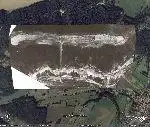One of the most remarkable advancements made by the German military in World War II was the production of turbine-jet aircraft. The most famous of these was the Messerschmitt Me 262, developed beginning in 1938 and fielded in 1944. A special production facility was started in 1944, for quicker assembly line manufacture. Due to the setup at the main Messerschmitt factories, fast assembly line production was not possible, and these sites were vulnerable to Allied bombing. Accordingly, a company called Flugzeugwerke Reichsmarschall Hermann Göring (REIMAHG for short) was formed as a subsidiary of the Gustloff Nazi industrial complex. REIMAHG eventually became concerned only with the Me 262, and its main production facility was located in an old porcelain sand mine in the Walpersberg Hill near Kahla (south of Jena) — Codename "Lachs" ("Salmon").
The existing tunnels in the Walpersberg were enlarged and others were dug, and massive concrete bunkers were built outside these tunnels. Subparts were made and partially assembled in the tunnels, then moved outside to the concrete bunkers, where final assembly took place. The assembled jets were then moved to the top of the hill via a platform that moved along a railed ramp by a power winch. The top of the Walpersberg had been leveled off and concreted in a massive construction effort, to form a runway some 3300 feet long. This was not sufficient for an Me 262 to take off (even with the jet engines, take-off was actually fairly slow), so small rockets assisted take-off. The runway was also too short for the jets to land, so leaving the Walpersberg was an all-or-nothing proposition: there could be no emergency landings. The jets were flown from Kahla to a site some 130 kilometers away to be fitted with weapons and radios, and to undergo final testing.
REIMAHG only managed to produce some twenty-seven Me 262 jet fighters by the end of the war. The work was done mostly by foreign forced laborers, some 991 of whom died during their nine months at "Lachs." The U.S. Army took the site on 12 April 1945, and before turning Thüringen over to the Soviets in July, they removed enough parts to finish five Me 262s that were found on the production line. Surprisingly, the Kahla area had not been bombed. British Intelligence had photographed Me 262s at the site in March 1945, so the Allies were well aware of "Lachs." But Kahla was spared the fate of the V-2 works at Nordhausen, which suffered a devastating bombing attack only eight days before the American Army arrived. (In spite of this historical report, the REIMAHG-Kahla site today shows many depressions that look very much like bomb craters that can be seen at such sites as Normandy and the Obersalzberg, and many areas that appear to have undergone explosive upheaval, all in areas that were flat during the war. This situation is apparently the result of Soviet activity after the war.)
Beginning in 1947, the Soviets blew up the concrete bunkers and assembly buildings, and also the entrances to most of the tunnels, including destruction of the concrete runway on the hilltop. However, the concrete buildings had reinforced walls some 10 feet thick, so in many cases, the explosions only collapsed the roofs. REIMAHG-Kahla remains today one of the most extensive Third Reich ruins sites, with the walls and foundations of most of the concrete assembly and workshop buildings, some still supporting parts of their roofs.

